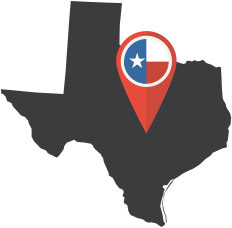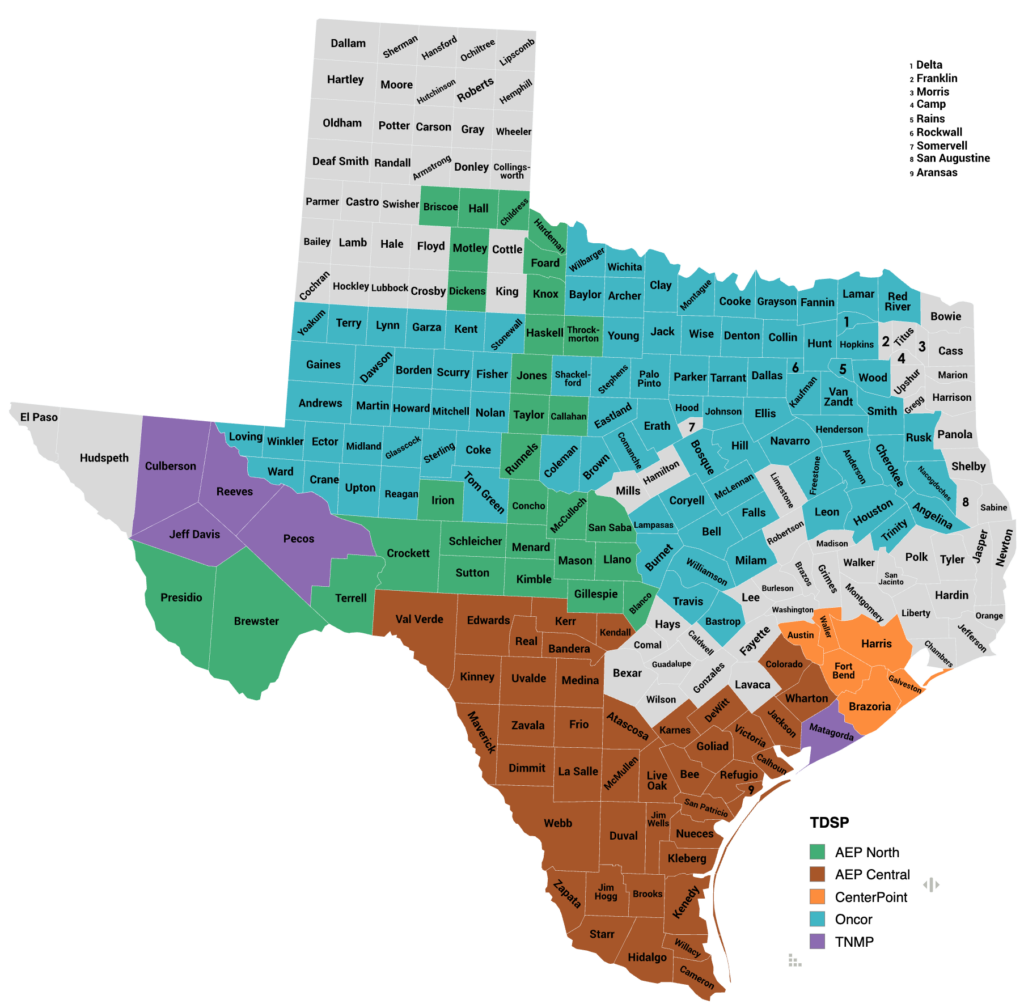
Last updated:
In Texas, there are three different roles a company can play:
- Generators are companies that produce electricity.
- Transmission and distribution service providers (TDSPs) are the companies that maintain wires and the poles that deliver energy.
- Retail electric providers (REPs) purchase electricity from the Generators, which they then resell to consumers and provide customer service and billing.
Remember, energy deregulation only applies to REPs. It’s not possible for residents to choose the TDSP, but they do have control over which REP they purchase energy from.
Map of Deregulated Counties in Texas

Highlighted counties are either partially or fully deregulated. Counties in gray are regulated.
Out of 254 counties in the state of Texas, 173 of them are at lease partially deregulated. Homes and businesses within those counties are able to switch to an energy plan offered by an alternative retail energy providers (REPs).
Major Deregulated Cities
Approximately 80-85% of homes and businesses in Texas reside within a “deregulated” energy market, meaning REPs operate within those markets and energy consumers (homes and businesses) there are able to shop for electricity rates and plans.
Top 50 Deregulated Cities in Texas
The table below provides a ranked list of the 50 most populous deregulated cities in Texas, including their primary utility company, county, and latest population estimates.
| Rank | City | Primary Utility | County | Population |
|---|---|---|---|---|
| 1 | Houston | CenterPoint Energy | Harris | 2,359,489 |
| 2 | Dallas | Oncor Electric Delivery | Dallas | 1,343,267 |
| 3 | Fort Worth | Oncor Electric Delivery | Tarrant | 986,843 |
| 4 | Arlington | Oncor Electric Delivery | Tarrant | 403,329 |
| 5 | Corpus Christi | AEP Texas | Nueces | 327,476 |
| 6 | Plano | Oncor Electric Delivery | Collin | 291,549 |
| 7 | Laredo | AEP Texas | Webb | 269,731 |
| 8 | Irving | Oncor Electric Delivery | Dallas | 261,535 |
| 9 | Garland | Oncor Electric Delivery | Dallas | 247,019 |
| 10 | Frisco | Oncor Electric Delivery | Collin | 243,363 |
| 11 | McKinney | Oncor Electric Delivery | Collin | 214,874 |
| 12 | Grand Prairie | Oncor Electric Delivery | Dallas | 207,639 |
| 13 | Killeen | Oncor Electric Delivery | Bell | 163,534 |
| 14 | Denton | Oncor Electric Delivery | Denton | 159,833 |
| 15 | Mesquite | Oncor Electric Delivery | Dallas | 150,974 |
| 16 | Pasadena | CenterPoint Energy | Harris | 149,943 |
| 17 | McAllen | AEP Texas | Hidalgo | 147,130 |
| 18 | Waco | Oncor Electric Delivery | McLennan | 143,626 |
| 19 | Midland | Oncor Electric Delivery | Midland | 139,428 |
| 20 | Carrollton | Oncor Electric Delivery | Dallas | 136,549 |
| 21 | Lewisville | Oncor Electric Delivery | Denton | 131,392 |
| 22 | Round Rock | Oncor Electric Delivery | Williamson | 129,773 |
| 23 | Abilene | AEP Texas | Taylor | 127,479 |
| 24 | Pearland | CenterPoint Energy | Brazoria | 126,497 |
| 25 | Richardson | Oncor Electric Delivery | Dallas | 121,324 |
| 26 | Odessa | Oncor Electric Delivery | Ector | 120,627 |
| 27 | Sugar Land | CenterPoint Energy | Fort Bend | 119,715 |
| 28 | League City | CenterPoint Energy | Galveston | 118,527 |
| 29 | Allen | Oncor Electric Delivery | Collin | 111,549 |
| 30 | Tyler | Oncor Electric Delivery | Smith | 110,958 |
| 31 | Wichita Falls | Oncor Electric Delivery | Wichita | 104,898 |
| 32 | Edinburg | AEP Texas | Hidalgo | 104,271 |
| 33 | San Angelo | AEP Texas | Tom Green | 101,613 |
| 34 | Temple | Oncor Electric Delivery | Bell | 92,572 |
| 35 | Mission | AEP Texas | Hidalgo | 88,963 |
| 36 | Baytown | CenterPoint Energy | Harris | 85,279 |
| 37 | Pharr | AEP Texas | Hidalgo | 80,147 |
| 38 | Missouri City | CenterPoint Energy | Fort Bend | 77,532 |
| 39 | Harlingen | AEP Texas | Cameron | 71,826 |
| 40 | North Richland Hills | Oncor Electric Delivery | Tarrant | 70,958 |
| 41 | Victoria | AEP Texas | Victoria | 67,574 |
| 42 | Rowlett | Oncor Electric Delivery | Dallas | 66,312 |
| 43 | Pflugerville | Oncor Electric Delivery | Travis | 65,923 |
| 44 | Euless | Oncor Electric Delivery | Tarrant | 61,032 |
| 45 | DeSoto | Oncor Electric Delivery | Dallas | 56,145 |
| 46 | Galveston | CenterPoint Energy | Galveston | 53,684 |
| 47 | Grapevine | Oncor Electric Delivery | Tarrant | 53,598 |
| 48 | Bedford | Oncor Electric Delivery | Tarrant | 49,928 |
| 49 | Cedar Hill | Oncor Electric Delivery | Dallas | 49,096 |
| 50 | Texas City | CenterPoint Energy | Galveston | 48,932 |
Commercial Electricity Rates
With several of the world’s major oil companies based or headquartered in the state of Texas, it is no surprise that oil and gas is a thriving industry. However, the state has many businesses in many industries that require electricity in order to run their day-to-day operations including:
- Agriculture
- Banking & Finance
- Aeronautics
- Small Business – Manufacturing and Non-Manufacturing
- Large Business – Manufacturing and Non-Manufacturing
- Tourism
- Computer Technology
- Government
- Entertainment
The amount of energy consumed is highly dependent on the number of machines operated by the company or business during the work day (and in some cases, after the work day has ended). Overall, there are 2 major sectors for energy consumption in Texas related to businesses. These sectors include:
- Commercial – Companies that fall within this sector uses over 12% of the state’s energy.
- Industrial – This sector consumes over 49% of the state’s energy.
Transportation is a third sector, and it consumes slightly above 24% of the state’s total energy usage.
Texas’ Energy Market
While energy deregulation created a shift in how electricity reaches its consumers, there are many other interesting facts about the Texan energy market:
- $1,801 is the average annual cost of electricity cost per household.
- It is the largest producer of lignite coal in the United States
- Petroleum refineries in this state have a capacity of 5.1 million barrels per day, which makes up 29% of the nations refining limit.
- In 2014, Texas generated 39 million megawatt hours from wind-powered energy generation.
- As of 2016, electricity prices in Texas have fallen for two consecutive years.
Power to Choose
Power to Choose is a program run by the Public Utility Commission of Texas. Its goal is to protect residents of the state from unfair energy costs and unregulated REPs, as well as develop a strong infrastructure. The program provides an easy to use, online tool that give residents of the state the opportunity to compare rates, plans and other energy options. Keep in mind though, you really need to read the fine print if you decide to use Power to Choose (or any other service, for that matter).
Residents and businesses in the state of Texas must remember that utilities are responsible for all energy related emergencies. REPs take care of the electricity supply, but they do not manage wires, poles, or outages.
As Texas’s largest city, Houston is the undeniable heart of the nation’s energy industry. It’s a sprawling, diverse metropolis with a world-class medical center and a major hand in aerospace.
Deregulation Status
Deregulated. If you live in Houston proper, you have the power to choose. Just keep in mind, some far-flung suburbs might be part of a local electric cooperative.
Primary Utility (TDSP)
CenterPoint Energy runs the show here. They manage all the power lines and are the ones you’ll call when a storm knocks the power out.
Biggest Retail Providers
The competition is intense. You’ll see offers from giants like Reliant, TXU Energy, and Gexa Energy, alongside dozens of other hungry providers.
Most Populated Zip Codes
- 77084, 77449, 77077, 77095
Average Electricity Rates
Residential: ~17.5 ¢/kWh
Commercial: ~10.1 ¢/kWh
Rates are recent market averages and change constantly. Always check the EFL for a specific plan’s rate.
Dallas stands tall as the commercial and cultural engine of North Texas. It’s a city built on finance, technology, and a healthy dose of Texas swagger, offering a dynamic urban experience.
Deregulation Status
Deregulated. Dallas residents enjoy a competitive electricity market. It’s worth noting that as the city expands, some newer neighborhoods on the northern edge might find themselves in co-op territory.
Primary Utility (TDSP)
Oncor Electric Delivery is the company behind the curtain, making sure the grid is reliable. They handle all infrastructure and outage calls.
Biggest Retail Providers
The Dallas market is a battleground for top providers. Expect to see aggressive marketing from TXU Energy, Reliant, 4Change Energy, and Gexa.
Most Populated Zip Codes
- 75228, 75217, 75227, 75243
Average Electricity Rates
Residential: ~17.3 ¢/kWh
Commercial: ~9.9 ¢/kWh
Rates are recent market averages and change constantly. Always check the EFL for a specific plan’s rate.
A key deepwater port city on Galveston Bay, Texas City is a major center for petrochemicals and refining. Its industrial might is a critical component of the Houston metro’s economic landscape.
Deregulation Status
Deregulated. Texas City is part of the competitive market, but it borders areas served by different utilities, so confirming your address is always a good idea.
Primary Utility (TDSP)
CenterPoint Energy is the primary utility for Texas City, managing the grid infrastructure.
Biggest Retail Providers
You’ll find all the major Houston-area providers here, including Reliant, Gexa, and Direct Energy.
Most Populated Zip Codes
- 77590, 77591
Average Electricity Rates
Residential: ~17.5 ¢/kWh
Commercial: ~10.1 ¢/kWh
Rates are consistent with the greater Houston area.
